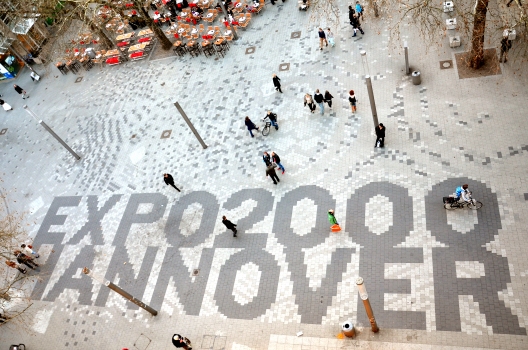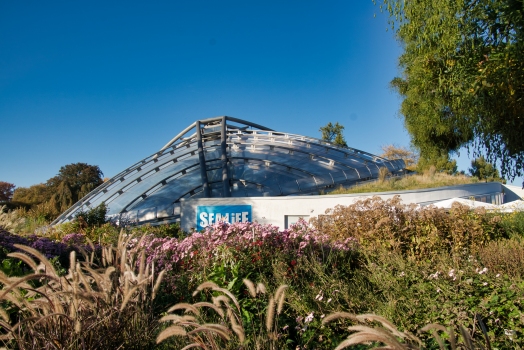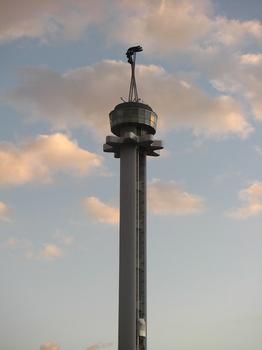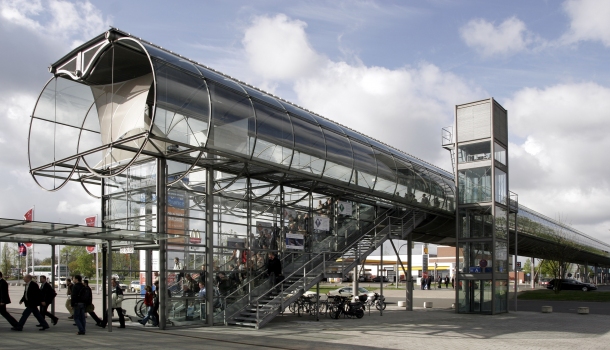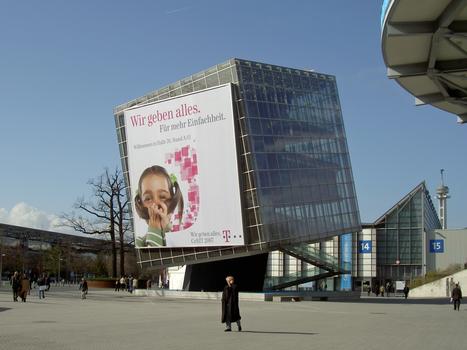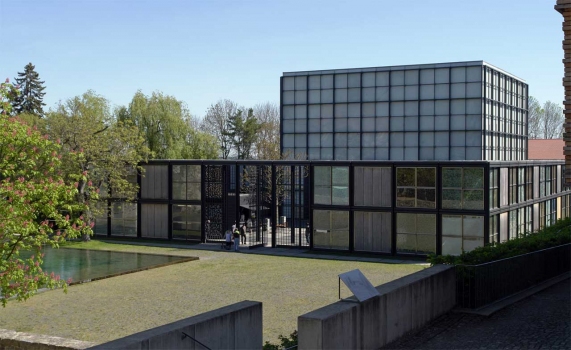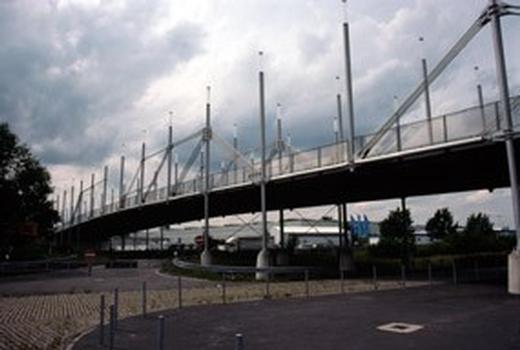General Information
| Other name(s): | World Exposition 2000 |
|---|---|
| Beginning of works: | 1 June 2000 |
| Completion: | 31 October 2000 |
| Status: | finished |
Project Type
| Event type: |
World's fair |
|---|
Location
| km | Name |
Technical Information
There currently is no technical data available.
Excerpt from Wikipedia
Expo 2000 was a World Expo held in Hanover, Germany from Thursday 1 June to Tuesday 31 October 2000. It was located on the Hanover Fairground (Messegelände Hannover), which is the largest exhibition ground in the world. Initially some 40 million people were expected to attend the exhibition over the course of months, however eventually with less than half of this number the Expo was a flop and turned out a financial failure.
The Expo's masterplan was designed in a joint venture with Studio d'Arnaboldi / Cavadini, Locarno and AS&P (Albert Speer und Partner GmbH).
History
Background
On 14 June 1990 the international organization sanctioning World Expos Bureau International des Expositions awarded Expo 2000 to Hanover, beating out Toronto by a 21 to 20 vote. In 1992, the architects Studio Arnaboldi/Cavadini of Locarno won an international design competition for the masterplan of the exhibition grounds. On 12 June that year, a survey conducted by the city council was made public showing only 51.5% of area residents supported hosting the expo.
Construction
On 5 May 1994 a new company was created by the government in Bonn, Gesellschaft zur Vorbereitung und Durchführung der Weltausstellung EXPO 2000 in Hannover (EXPO 2000 Hannover GmbH). Headed by chairman Helmut Werner, the company was responsible for the construction and management of the Expo.
In 1995 the supervisory board agreed on the concept for the thematics of the Expo. Construction finally began on 22 April 1996.
Unlike previous expos, which focused on present advances in science and technology, EXPO 2000 focused more on developing and presenting solutions for the future.
World Expo 2000
The Expo opened to the public on Thursday 1 June 2000 and ran for five months, ending on Tuesday 31 October.
The Expo site was situated on the original 1,000,000 square meters of the Hanover fairground; an additional 600,000 m² was also made available as a newly opened section to the grounds. As a visitor walked in and tickets were taken, looking above to the approximately four-story-high ceiling, a visitor would have noticed the huge circular pods that held large TVs showing animated people greeting the visitors and providing tourist information in different languages. Some ten large McDonald's restaurants were also built, along with restaurants representing several of the exhibitor countries. Small retail locations were also set up to supply Expo merchandise. The United States reversed its decision to take part at a relatively late stage, and the area set aside for the American pavilion was left undeveloped.
40,000,000 visitors were expected at Expo 2000, but only 25,210,000 people came to see the event. This led to a financial deficit of about $600,000,000. With pre-ordered tickets priced at 69 DM, the Expo seemed expensive compared to other days out. Commentator Georg Giersberg wrote in the Frankfurter Allgemeine that entrance fees for Germany's 53 main theme parks cost on average less than half the price of the Expo (about 30 DM). Other financial shortfalls came from a lack of corporate sponsorship, since it cost US$4.8 million to be an official product supplier or US$14.5 million to become a world partner.
Part of the failure of the Expo was a lack of clear perception of what to expect at Expo 2000, not helped by a "cerebral" advertising campaign that had failed to explain what the Expo was for. In a 2000 Time article, a Berlin-based marketing firm, Scholz & Friends, stated that "the organizers have failed to convey to the public a clear image of what Expo 2000 is going to be: an entertainment park, a blown-up museum, or a nature reserve." In the same article, Ralf Strobach, secretary of Hanover's Citizens' Initiative for Environment Protection, said that "For a long time, companies were unsure if they would be putting money in an eco-show or a showcase for their latest inventions." Only after the Expo was open and clearly not meeting expectations was a new advertising campaign created, aimed at the domestic market with British actor Peter Ustinov and German television star Verona Feldbusch and stressing the fun side of the Expo, under the slogan "Das gibt's nur einmal, es kommt nie wieder" ("This only happens once, it's never coming back").
The German band Kraftwerk created a vocoded speech signature theme, "Expo 2000", which was also developed into a single of the same name. Later, a remix single "Expo Remix" was released. The band was also paid US$190,000 for a five-second jingle, leading Chancellor Gerhard Schröder to state that he "wouldn't have spent so much money".
Settlement
The western slope of Kronsberg emerged in the late 1990s in conjunction with the EXPO 2000, established an environmental point of settlement at the Hannover Expo. The district is a result of independent evolutionary history and unique structure often perceived as a separate district.
Pavilions
Themed
- The 21st Century
- Planet of Visions
- Human
- Knowledge
- Mobility
- Communication
- Energy
- Health
- Nutrition
- Environment
- Basic Needs
- Future of Labour
National
This section's use of external links may not follow Wikipedia's policies or guidelines. Please improve this article by removing excessive or inappropriate external links, and converting useful links where appropriate into footnote references. (April 2016)
In total, 155 nations took part. Some are outlined below:
- – The Bhutan Pavilion A Buddhist Temple brought from Bhutan to the World Exhibition in Hannover, having been prefabricated in 16,000 construction parts in Bhutan.
- Finland – Titled "Wind Nest", the building was created by architects Sarlotta Narjus and Antti-Matti Siikala. Four-storey twin buildings measuring 50 x 7.5 m each were clad in heat-treated thermowood. The two buildings were connected by bridges, allowing visitors to move amongst the three exhibit halls on the first two stories. A 15 m wide birch forest was also created.
- Germany – Designed by architect Wund Gruppe, the 24,000 m² building was the largest nation pavilion at Expo.
- Japan – The Japanese Pavilion was a gridshell structure made out of recycled paper tubes that created a honeycomb-like building. The German authorities refused to allow a paper-only structure, literally held together at the joints by tape, so a secondary supporting structure made of wood was created to obtain the needed legal approval. Designed by architect Shigeru Ban along with consultants Frei Otto (the German architect who created the Olympic Stadium (Munich) and the German pavilion at Expo 67 in Montreal), Buro Happold (the British engineering firm which created the Millennium Dome) and Stefan Polonyi (a structural engineering professor), the building took 3 weeks to assemble and covered an exhibit area of 72 m (long) x 35 m (wide) x 15.5 m (high), pavilion lot size: 5,450 m² and building surface area: 3,600 m².
- Latvia – about 300,000 people participated in the "Zime" project created by Armands Strazds and Modris Tenisons.
- Lithuania – The pavilion was designed by Marina and Audrius Bučas, Gintaras Kuginys, Valdas Ozarinskas and Aida Čeponytė. The building was a futuristic glossy yellow. The main attraction was the film "Flight over Lithuania".
- Mexico – The pavilion consisted of five separate buildings linked by ramps, and after the Expo, was relocated to the Braunschweig Fine Arts College. The architect was Ricardo Legorreta.
- Monaco – Monaco contributed at the exhibition by constructing a hypermodern modular prefabricated pavilion which was designed by the architect Hans Ferdinand Degraeuwe.
- Mongolia –Mongolia participated at the exhibition by constructing a nomadic town of the 13th century, called "Chingis’s Town", covering one hectare. The pavilion was designed by the architect Adiya Baldandorj Bayud, to show the ger residences of Great Khans of the Mongol Empire of the 13th century. The feature of this town was that it created the town with ger, ger-carriage and various kinds of cotton residents, which are different in forms, sizes and applications, used by Mongolians of that century. Moreover, the King’s privilege armchair, clothing and accessories of ancient heroes and weapons were shown in the "Chingis's Town".http://mongolwall.com/mw_wp/
- Netherlands was located at '3' Europa Boulevard, and the Dutch pavilion was one of the most popular buildings, winning international acclaim, and was designed by the firm MVRDV. The theme of the 36 m high building (the Expo's tallest structure) was "Holland creates Space". Six Holland eco-system landscapes were stacked to showcase how a country can make the most out of a small space. Guests entered on the ground floor and moved through the exhibit space via grand exterior staircases that wrapped around the building. The top level contained a small lake surrounded with windmills that generated power for the building. The interior spaces were designed by MET Studio. The original plan was to dismantle the building and move it back to Amsterdam, but it was determined that it would be much cheaper to just create a new building from scratch. As of 2006, the building sits empty and is partially looted with windows smashed and garbage everywhere. Photos of the building in its current state; also visit: for more updates on the pavilion.
- Portugal – Designed by architects Álvaro Siza Vieira and Eduardo Souto de Moura, the 2,350 m² pavilion was located on the Europa Boulevard. The prefabricated two-story building was covered with around 55 tons of expanded cork agglomerate and with hand-made glazed tiles on the patio and had a double glass fibre canvas membrane roof. Portugal Pavilion Website
- Spain – Designed with the theme "Familiarity and Solidarity" [ Spain Pavilion Website]
- Switzerland – The 3019 square meter pavilion designed by Peter Zumthor was built of stacked wooden beams of larchwood and Scots pine held together by steel rods and springs
- UAE United Arab Emirates – The 3000 m² pavilion, situated on a 6000 m² plot (the largest of the Expo sites), was a recreated desert fort. Designed by the French architect Alain Durand-Heriot, the exhibit tried to evoke the feeling of being in the Arab state. The main attraction was a 360° circular cinema. The building was 84 m × 36 m and built out of recyclable materials. The theme of the pavilion was "From the traditional to the modern" and presented the history of the country.
- Venezuela – The pavilion was a convertible tent structure which opened and closed like a flower. It was very lightweight, was constructed with no waste and completely re-usable. The flower petals were positioned according to the weather, to shade, keep dry or allow sun to shine on the pavilion. It was designed by Fruto Vivas and Frei Otto with SL Rasch.
Other
- Planet m – Media for Mankind – The Bertelsmann pavilion, designed by TRIAD Berlin, explored the importance of the media. Guests were brought to the exhibition by the world's largest elevator, which could transport up to 200 people at once. Today, the building is used by the University of Applied Sciences Hannover.
- BMW World – The exhibit focused on BMW's efforts to create clean-energy operated vehicles. The BMW 750hL Clean Energy car was on display. There were also exhibits on the possibilities of solar- and water-fueled cars. Daimler Chrysler also operated Lab.01, an interactive laboratory showcasing mobility devices including mini-robots.
- EU European Union – The pavilion presented the European Union's vision of Europe. The walk-through exhibit was divided into seven zones: 50's, Time Shuttle, Euro, Blue Planet, Bridge, Tunnel, Here and Now. Pavilion Webpage
- Global House – The building housed the One World Cafe and a variety of exhibits, including Indigenous Peoples' Wisdom from the Earth, a display of 26 initiatives by indigenous groups from around the globe. Each initiative was shown in a flight case and featured text, images, and in many cases, contemporary handicraft. The exhibit was the first opportunity for indigenous people to represent themselves at a World Expo.
- WWF (World Wildlife Fund) – Pavilion
- The ZERI Pavilion – The largest bamboo structure designed by Simon Velez, was built by 41 Colombian wood workers in less than three months. Over 4,500 bamboos (Guadua angustifolia) were joined to become the first building which dances with the rhythm of the earth — and this with a German building permit. Nine months of intensive scientific research and testing first enabled the acquisition of a temporary permit, and after the building was constructed twice (once in Manizales, Colombia and once in Hanover), the final permit was granted the day before the opening of the Expo 2000. This pavilion presented seven projects from around the world which demonstrated that it is possible to respond to everyone's needs on Earth with what we have. The projects from Colombia, Zimbabwe, Fiji, Sweden and Japan inspired many young people. The pavilion nearly went bankrupt when sales and attendance were so low, but thanks to a single bamboo in the center of the pavilion, enough money was collected to make it to the end. The ZERI Pavilion had an estimated 6.4 million visitors, but it had no doors and no queues. for information on ZERI today
- Christ Pavilion – Christ Pavilion of the Protestant and Catholic churches in Germany, 2001 reconstructed at the monastery Volkenroda.
Projects
- Lost Paradise Lost - art meets church
- Rain Forest House - hear, smell, taste and feel the diversity of the tropical highland rain forest
- Hannover Zoo - where the animals can live in conditions similar to their natural habitats
- Hornemann Institute - worldwide knowledge transfer as well as further education in the field of conservation and restoration
- Worlds Children Peace Monument (WCPM) - conceived during EXPO 2000's Culture on the Move segment in cooperation with the United Nations 2000 Culture of Peace Program. The WCPM project, still in use today, encourages positive community participation through the establishment of works of public art, through cultural education and entrepreneurial training to children around the World.
Legacy
Glass sculpture "United Earth" by Tomasz Urbanowicz from EXPO 2000, rebuild in the European Parliament in Strasbourg. The Nepal Himalaya Pavilion from the Expo 2000, rebuilt with a small botanical garden at Wiesent near Regensburg
Some of the buildings on the Expo site were sold after EXPO 2000 ended, but most of the exhibition area is still used for major fairs in Germany, as it has been since 1949. The southeastern area around Expo Plaza has been turned into Hanover's new centre of information technology, design, media and arts.
Most of the national pavilion buildings were demolished, or disassembled and shipped to their home countries, following the Expo. Some buildings were retained, including the Netherlands Pavilion. The structure has now fallen into disrepair, until earlier in December 2017, when architecture company MVRDV announced plans to restore and renovate the Netherlands pavilion to accommodate future users.
A glass sculpture called "United Earth" by Tomasz Urbanowicz exhibited as part of the Lower Silesian Presentation in the Polish Pavillion was later handed over by the City of Wrocław to the European Parliament in Strasbourg. The sculpture is the main central point of the Agora of the Louise Weiss building designed by Architecture-Studio.
Text imported from Wikipedia article "Expo 2000" and modified on May 19, 2020 according to the CC-BY-SA 4.0 International license.
Participants
Relevant Web Sites
Relevant Publications
- Architektur mit Stahl zur Weltausstellung EXPO 2000. Stahl-Informations-Zentrum, Düsseldorf (Germany), 2000, pp. 66.
- (2000): Architekturführer Hannover. Architectural Guide to Hannover. 1st edition, Dietrich Reimer Verlag, Berlin (Germany), pp. 181-226.
- (2000): Der Bambus-Pavillon zur EXPO 2000 in Hannover. Ein Schritt zurück in die Zukunft. In: Bautechnik, v. 77, n. 6 (June 2000), pp. 385-392.
- (2000): Der Bambus-Pavillon zur EXPO 2000 in Hannover Ein Schritt zurück in die Zukunft (Teil 2). In: Bautechnik, v. 77, n. 7 (July 2000), pp. 484-491.
- Christus-Pavillon. Von der EXPO 2000 Hannover nach Volkenroda (Thüringen) - Demontage und Wiederaufbau. Stahl-Informations-Zentrum, Düsseldorf (Germany), 2002, pp. 25.
- About this
data sheet - Structure-ID
10000014 - Published on:
30/05/2000 - Last updated on:
20/01/2022

